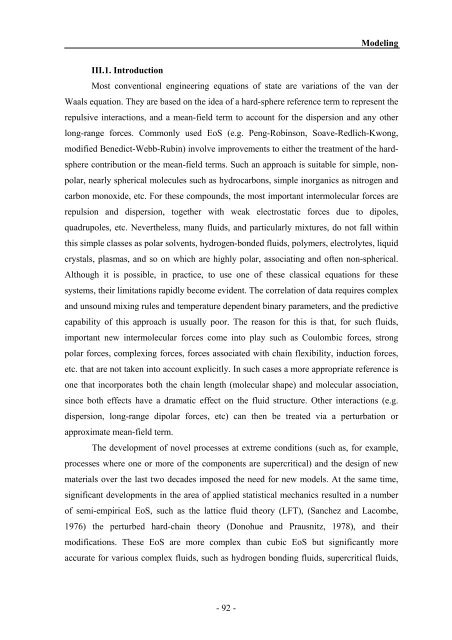n - PATh :.: Process and Product Applied Thermodynamics research ...
n - PATh :.: Process and Product Applied Thermodynamics research ...
n - PATh :.: Process and Product Applied Thermodynamics research ...
Create successful ePaper yourself
Turn your PDF publications into a flip-book with our unique Google optimized e-Paper software.
III.1. Introduction<br />
Modeling<br />
Most conventional engineering equations of state are variations of the van der<br />
Waals equation. They are based on the idea of a hard-sphere reference term to represent the<br />
repulsive interactions, <strong>and</strong> a mean-field term to account for the dispersion <strong>and</strong> any other<br />
long-range forces. Commonly used EoS (e.g. Peng-Robinson, Soave-Redlich-Kwong,<br />
modified Benedict-Webb-Rubin) involve improvements to either the treatment of the hardsphere<br />
contribution or the mean-field terms. Such an approach is suitable for simple, nonpolar,<br />
nearly spherical molecules such as hydrocarbons, simple inorganics as nitrogen <strong>and</strong><br />
carbon monoxide, etc. For these compounds, the most important intermolecular forces are<br />
repulsion <strong>and</strong> dispersion, together with weak electrostatic forces due to dipoles,<br />
quadrupoles, etc. Nevertheless, many fluids, <strong>and</strong> particularly mixtures, do not fall within<br />
this simple classes as polar solvents, hydrogen-bonded fluids, polymers, electrolytes, liquid<br />
crystals, plasmas, <strong>and</strong> so on which are highly polar, associating <strong>and</strong> often non-spherical.<br />
Although it is possible, in practice, to use one of these classical equations for these<br />
systems, their limitations rapidly become evident. The correlation of data requires complex<br />
<strong>and</strong> unsound mixing rules <strong>and</strong> temperature dependent binary parameters, <strong>and</strong> the predictive<br />
capability of this approach is usually poor. The reason for this is that, for such fluids,<br />
important new intermolecular forces come into play such as Coulombic forces, strong<br />
polar forces, complexing forces, forces associated with chain flexibility, induction forces,<br />
etc. that are not taken into account explicitly. In such cases a more appropriate reference is<br />
one that incorporates both the chain length (molecular shape) <strong>and</strong> molecular association,<br />
since both effects have a dramatic effect on the fluid structure. Other interactions (e.g.<br />
dispersion, long-range dipolar forces, etc) can then be treated via a perturbation or<br />
approximate mean-field term.<br />
The development of novel processes at extreme conditions (such as, for example,<br />
processes where one or more of the components are supercritical) <strong>and</strong> the design of new<br />
materials over the last two decades imposed the need for new models. At the same time,<br />
significant developments in the area of applied statistical mechanics resulted in a number<br />
of semi-empirical EoS, such as the lattice fluid theory (LFT), (Sanchez <strong>and</strong> Lacombe,<br />
1976) the perturbed hard-chain theory (Donohue <strong>and</strong> Prausnitz, 1978), <strong>and</strong> their<br />
modifications. These EoS are more complex than cubic EoS but significantly more<br />
accurate for various complex fluids, such as hydrogen bonding fluids, supercritical fluids,<br />
- 92 -



